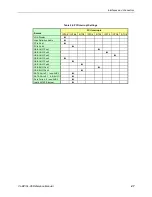
Interfaces and Connectors
VL-EPICs-36 Reference Manual
42
SPX™ Expansion Bus (J22)
Up to four serial peripheral expansion (SPX) devices can be attached to the VL-EPICs-36 at
connector JN1 using the VL-CBR-1401 or VL-CBR-1402 cable. The SPX interface provides the
standard serial peripheral interface (SPI) signals: SCLK, MISO, and MOSI, as well as four chip
selects, SS0# to SS3#, and an interrupt input, SINT#.
The 5.0V power provided to pins 1 and 14 of JN1 is protected by a 1 Amp fuse.
Table 20: SPX Expansion Bus Pinout
J22
Pin
Signal
Name
Function
1
V5_0
+5.0V (Protected)
2
SCLK
Serial Clock
3
GND
Ground
4
MISO
Serial Data In
5
GND
Ground
6
MOSI
Serial Data Out
7
GND
Ground
8
SS0#
Chip Select 0
9
SS1#
Chip Select 1
10
SS2#
Chip Select 2
11
SS3#
Chip Select 3
12
GND
Ground
13
SINT#
Interrupt Input
14
V5_0
+5.0V (Protected)
SPI is, in its simplest form, a three wire serial bus. One signal is a Clock, driven only by the
permanent Master device on-board. The others are Data In and Data Out with respect to the
Master. The SPX implementation adds additional features, such as chip selects and an interrupt
input to the Master. The Master device initiates all SPI transactions. A slave device responds
when its Chip Select is asserted and it receives Clock pulses from the Master.
The SPI clock rate can be software configured to operate at speeds between 1 MHz and 8 MHz.
Please note that since this clock is divided from a 33 MHz PCI clock, the actual generated
frequencies are not discrete integer MHz frequencies. All four common SPI modes are supported
through the use of clock polarity and clock idle state controls.
V
ERSA
L
OGIC
SPX
E
XPANSION
M
ODULES
VersaLogic offers a number of SPX modules that provide a variety of standard functions, such as
analog input, digital I/O, CANbus controller, and others. These are small boards (1.2” x 3.775”)
that can mount on the PC/104 stack, using standard PC/104 stand-offs, or up to two feet away
from the base board. For more information, contact VersaLogic at

























